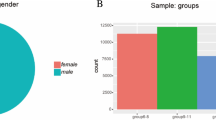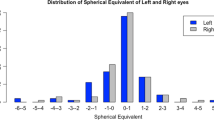Abstract
Background
This study focuses on the refractive implications of albinism in Malawi, which is mostly associated with the burden of visual impairment. The main goal was to describe the refractive errors and to analyze whether patients with albinism in Malawi, Sub-Saharan Africa, benefit from refraction.
Methods
Age, sex, refractive data, uncorrected and best-corrected visual acuity (UCVA, BCVA), colour vision, contrast sensitivity, and the prescription of sunglasses and low vision devices were collected for a group of 120 albino individuals with oculocutaneous albinism (OCA). Refractive errors were evaluated objectively and subjectively by retinoscopy, and followed by cycloplegic refraction to reconfirm the results. Best-corrected visual acuity (BCVA) was also assessed binocularly.
Results
One hundred and twenty albino subjects were examined, ranging in age from 4 to 25 years (median 12 years), 71 (59 %) boys and 49 (41 %) girls. All exhibited horizontal pendular nystagmus. Mean visual acuity improved from 0.98 (0.33) logMAR to 0.77 (0.15) logMAR after refraction (p < 0.001). The best improvement of VA was achieved in patients with mild to moderate myopia. Patients with albinism who were hyperopic more than +1.5 D hardly improved from refraction. With the rule (WTR) astigmatism was more present (37.5 %) than against the rule (ATR) astigmatism (3.8 %). Patients with astigmatism less than 1.5 D improved in 15/32 of cases (47 %) by 2 lines or more. Patients with astigmatism equal to or more than 1.5 D in any axis improved in 26/54 of cases (48 %) by 2 lines or more.
Conclusions
Refraction improves visual acuity of children with oculocutaneous albinism in a Sub-Saharan African population in Malawi. The mean improvement was 2 logMAR units.






Similar content being viewed by others
References
Bennett DC, Lamoreux ML (2003) The color loci of mice—a genetic century. Pigment Cell Res 16(4):333–344
Naumann GOH, Lerche W, Schroeder W (1976) Foveolar aplasia in tyrosinase-positive oculocutaneous albinisim. Albrecht von Graefes Arch Klin Exp Ophthalmol 200(1):39–50, German
Fulton AB, Albert DM, Craft JL (1978) Human albinism. Light and electron microscopy study. Arch Ophthalmol 96(2):305–310
Abadi RV, Cox MJ (1992) The distribution of macular pigment in human albinos. Invest Ophthalmol Vis Sci 33(3):494–497
Ezeilo BN (1989) Psychological aspects of albinism: an exploratory study with Nigerian (Igbo) albino subjects. Soc Sci Med 29(9):1129–1131
Hong ES, Zeeb H, Repacholi MH (2006) Albinism in Africa as a public health issue. BMC Public Health 17(6):212
Lund PM, Gaigher RA (2002) A health intervention programme for children with albinism at a special school in South Africa. Health Educ Res 17:365–372
Kiprono SK, Masenga JE, Chaula BM, Naafs B (2012) Skin flora: differences between people affected by albinism and those with normally pigmented skin in Northern Tanzania—cross sectional study. BMC Dermatol 12:12. doi:10.1186/1471-5945-12-12
Anderson J, Lavoie J, Merrill K, King RA, Summers CG (2004) Efficacy of spectacles in persons with albinism. J AAPOS 8(6):515–520
Käsmann B, Ruprecht KW (1996) Might the refractive state in oculocutaneous albino patients be a clue for distinguishing between tyrosinase-positive and tyrosinasenegative forms of oculocutaneous albinism? Ger J Ophthalmol 5(6):422–427
Sampath V, Bedell HE (2002) Distribution of refractive errors in albinos and persons with idiopathic congenital nystagmus. Optom Vis Sci 79(5):292–299
Wildsoet CF, Oswald PJ, Clark S (2000) Albinism: its implications for refractive development. Invest Ophthalmol Vis Sci 41(1):1–7
Gilbert C, Foster A, Negrel AD, Thylefors B (1993) Childhood blindness: a new form for recording causes of visual loss in children. Bull World Health Organ 71(5):485–489
Eballé AO, Mvogo CE, Noche C, Zoua ME, Dohvoma AV (2013) Refractive errors in Cameroonians diagnosed with complete oculocutaneous albinism. Clin Ophthalmol 7:1491–1495
Guo Y, Liu LJ, Xu L, Lv YY, Tang P, Feng Y, Meng M, Jonas JB (2013) Outdoor activity and myopia among primary students in rural and urban regions of Beijing. Ophthalmology 120(2):277–283
Yahalom C, Tzur V, Blumenfeld A, Greifner G, Eli D, Rosenmann A, Glanzer S, Anteby I (2012) Refractive profile in oculocutaneous albinism and its correlation with final visual outcome. Br J Ophthalmol 96(4):537–539
Mvogo CE, Bella-Hiag AL, Ellong A, Mbarga BM (1999) Visual problems in albinos: a hospital study carried out at the Douala General Hospital. Santé 9(2):89–91
Mártinez-García M, Montoliu L (2013) Albinism in Europe. J Dermatol 40(5):319–324
Schneier AJ, Fulton AB (2013) The Hermansky–Pudlak syndrome: clinical features and imperatives from an ophthalmic perspective. Semin Ophthalmol 28(5–6):387–391
Lynch P, Lund P (2011) Education of children and young people with albinism in Malawi. Ministry of Education, Science, and Technology Malawi. Final report. Commonwealth Secretariat, London, pp. 5–6
Acknowledgments
We thank Sight Savers (SS) for supporting refractive and low-vision care for patients with albinism in Malawi. We thank Else Kröner–Fresenius Stiftung for supporting the College of Medicine, Blantyre, Malawi. We thank Professor. Dr. Peter König, Mechanical and Automotive Engineering, Trier University of Applied Sciences, for the statistical support.
Conflict of interest
All authors certify that they have NO affiliations with or involvement in any organization or entity with any financial interest (such as honoraria; educational grants; participation in speakers’ bureaus; membership, employment, consultancies, stock ownership, or other equity interest; and expert testimony or patent-licensing arrangements), or non-financial interest (such as personal or professional relationships, affiliations, knowledge or beliefs) in the subject matter or materials discussed in this manuscript.
Authorship according to ICMJE guidelines
M Schulze Schwering, N Kumar, K Kalua, and P Kayange: designed study
M Schulze Schwering, N Kumar, and K Kalua: collected data
M Schulze Schwering, N Kumar, D. Bohrmann, M Spitzer, and P Kayange: did study analysis
M Schulze Schwering, M Spitzer, and P Kayange: edited manuscript for submission.
M Schulze Schwering, N Kumar, D Bohrmann, G Msukwa, K Kalua, M Spitzer, and P Kayange: Reviewed manuscript before submission
M Schulze Schwering, N Kumar, G Msukwa, M Spitzer, K Kalua, and P Kayange: agreed to manuscript being published.
Competing interests
None.
Author information
Authors and Affiliations
Corresponding author
Rights and permissions
About this article
Cite this article
Schulze Schwering, M., Kumar, N., Bohrmann, D. et al. Refractive errors, visual impairment, and the use of low-vision devices in albinism in Malawi. Graefes Arch Clin Exp Ophthalmol 253, 655–661 (2015). https://doi.org/10.1007/s00417-015-2943-0
Received:
Revised:
Accepted:
Published:
Issue Date:
DOI: https://doi.org/10.1007/s00417-015-2943-0




